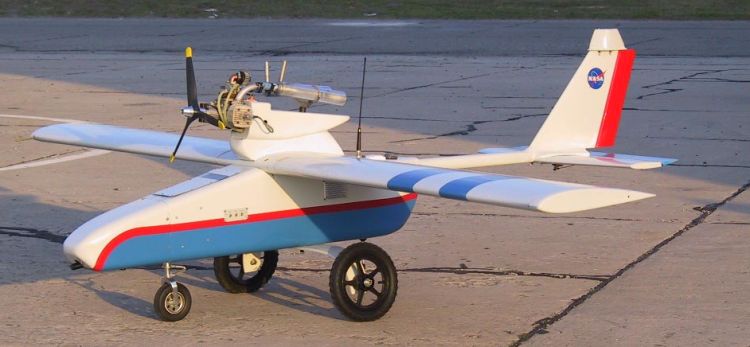BAI XPV-1 Tern
The development of the Tern low-cost mini-UAV was originally begun by H-Cubed Corporation, but the program was acquired by BAI Aerosystems in 1993. Use by the U.S. military in the late 1990s was limited to a few examples for research purposes. Tern UAVs were modified by the U.S. Army for fiber-optic guidance to act as a surrogate fiber-optic guided missile (FOG-M). Other Army research Terns evaluated NBC (Nuclear/Biological/Chemical) sensor payloads. In 2001, the Tern was modified into the XPV-1 tactical UAV for special operations.
The Tern is powered by a two-stroke piston engine and is equipped with a conventional tricycle undercarriage for wheeled take-off and landing. In the XPV-1, the landing gear is fitted with relatively large low-pressure tyres and electronically actuated brakes for operations on rough terrain. The UAV is equipped with a state-of-the-art GPS waypoint navigation system and a microwave datalink to transmit video imagery and other sensor data to the operator. Standard payload are forward and side-looking color TV cameras. Maximum payload capacity is 1.4 kg (3 lb) in the nose and 10 kg (22 lb) under the body. Options include a BAI pan/tilt/zoom TV camera, a BAI pan/tilt IR imager, jammers, and other types of intelligence gathering sensors.
 |
| Photo: NASA |
| Tern |
The XPV-1 Tern was first used operationally in 2001 by the U.S. Navy in Afghanistan to support Special Operation Forces. The UAV was fitted with a belly-mounted dispenser to drop an unattended sensor. A total of 65 XPV-1 UAVs have been delivered to the U.S. military forces.
Designation Note: The significance of the XPV-1 is not known, but it is most likely a company designator and not a military nomenclature. As a mini-UAV, the Tern should receive an official RQ-nn MDS designation.
Specifications
Note: Data given by several sources show slight variations. Figures given below may therefore be inaccurate!
Data for XPV-1 Tern:
| Length | 2.71 m (8 ft 10.8 in) |
| Wingspan | 3.45 m (11 ft 4 in) |
| Height | 1.02 m (3 ft 4 in) |
| Weight | 59 kg (130 lb) |
| Speed | max: 125 km/h (78 mph); cruise: 84 km/h (52 mph) |
| Ceiling | 3000 m (10000 ft) |
| Range | 75 km (40 nm) |
| Endurance | 4 h |
| Propulsion | 3W piston engine; 9 kW (12 hp) |
Main Sources
[1] Kenneth Munson (ed.): "Jane's Unmanned Aerial Vehicles and Targets, Issue 15", Jane's, 2000
[2] "Unmanned Aircraft Systems Roadmap, 2005-2030", Office of the Secretary of Defense, August 2005
[3] BAI Website
Back to Directory of U.S. Military Rockets and Missiles, Appendix 4
Last Updated: 1 September 2005